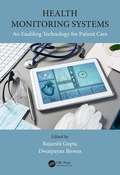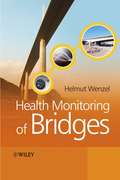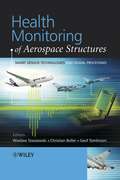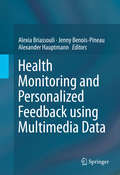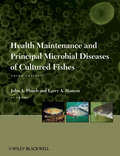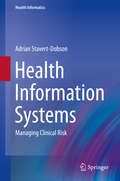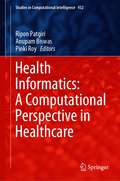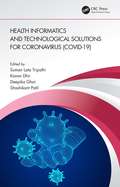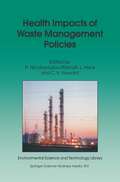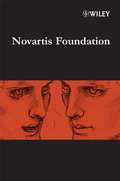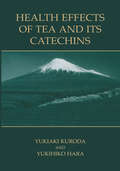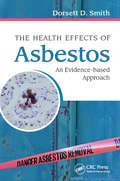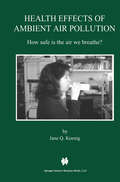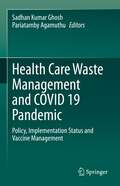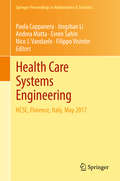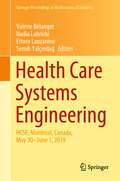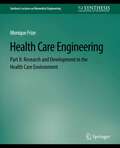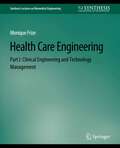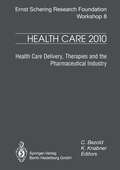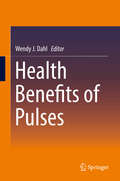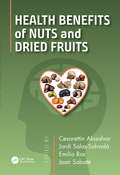- Table View
- List View
Health Monitoring Systems: An Enabling Technology for Patient Care
by Rajarshi Gupta Dwaipayan BiswasRemote health monitoring using wearable sensors is an important research area involving several key steps: physiological parameter sensing and data acquisition, data analysis, data security, data transmission to caregivers, and clinical intervention, all of which play a significant role to form a closed loop system. Subject-specific behavioral and clinical traits, coupled with individual physiological differences, necessitate a personalized healthcare delivery model for around-the-clock monitoring within the home environment. Cardiovascular disease monitoring is an illustrative application domain where research has been instrumental in enabling a personalized closed-loop monitoring system, which has been showcased in this book. Health Monitoring Systems: An Enabling Technology for Patient Care provides a holistic overview of state-of-the-art monitoring systems facilitated by Internet of Things (IoT) technology. The book lists out the details on biomedical signal acquisition, processing, and data security, the fundamental building blocks towards an ambulatory health monitoring infrastructure. The fundamentals have been complimented with other relevant topics including applications which provide an in-depth view on remote health monitoring systems. Key Features: Presents examples of state-of-the-art health monitoring systems using IoT infrastructure Covers the full spectrum of physiological sensing, data acquisition, processing, and data security Provides relevant example applications demonstrating the benefits of technological advancements aiding disease prognosis This book serves as a beginner’s guide for engineering students of electrical and computer science, practicing engineers, researchers, and scientists who are interested in having an overview of pervasive health monitoring systems using body-worn sensors operating outside the hospital environment. It could also be recommended as a reference for a graduate or master’s level course on biomedical instrumentation and signal processing.
Health Monitoring Systems: An Enabling Technology for Patient Care
by Rajarshi Gupta Dwaipayan BiswasRemote health monitoring using wearable sensors is an important research area involving several key steps: physiological parameter sensing and data acquisition, data analysis, data security, data transmission to caregivers, and clinical intervention, all of which play a significant role to form a closed loop system. Subject-specific behavioral and clinical traits, coupled with individual physiological differences, necessitate a personalized healthcare delivery model for around-the-clock monitoring within the home environment. Cardiovascular disease monitoring is an illustrative application domain where research has been instrumental in enabling a personalized closed-loop monitoring system, which has been showcased in this book. Health Monitoring Systems: An Enabling Technology for Patient Care provides a holistic overview of state-of-the-art monitoring systems facilitated by Internet of Things (IoT) technology. The book lists out the details on biomedical signal acquisition, processing, and data security, the fundamental building blocks towards an ambulatory health monitoring infrastructure. The fundamentals have been complimented with other relevant topics including applications which provide an in-depth view on remote health monitoring systems. Key Features: Presents examples of state-of-the-art health monitoring systems using IoT infrastructure Covers the full spectrum of physiological sensing, data acquisition, processing, and data security Provides relevant example applications demonstrating the benefits of technological advancements aiding disease prognosis This book serves as a beginner’s guide for engineering students of electrical and computer science, practicing engineers, researchers, and scientists who are interested in having an overview of pervasive health monitoring systems using body-worn sensors operating outside the hospital environment. It could also be recommended as a reference for a graduate or master’s level course on biomedical instrumentation and signal processing.
Health Monitoring of Bridges
by Helmut WenzelHealth Monitoring of Bridges prepares the bridge engineering community for the exciting new technological developments happening in the industry, offering the benefit of much research carried out in the aerospace and other industrial sectors and discussing the latest methodologies available for the management of bridge stock. Health Monitoring of Bridges: Includes chapters on the hardware used in health monitoring, methodologies, applications of these methodologies (materials, methods, systems and functions), decision support systems, damage detection systems and the rating of bridges and methods of risk assessment. Covers both passive and active monitoring approaches. Offers directly applicable methods and as well as prolific examples, applications and references. Is authored by a world leader in the development of health monitoring systems. Includes free software that can be downloaded from http://www.samco.org/ and provides the raw data of benchmark projects and the key results achieved. This book provides a comprehensive guide to all aspects of the structural health monitoring of bridges for engineers involved in all stages from concept design to maintenance. It will also appeal to researchers and academics within the civil engineering and structural health monitoring communities.
Health Monitoring of Aerospace Structures: Smart Sensor Technologies and Signal Processing
by Wieslaw J. Staszewski Christian Boller Geoff TomlinsonProviding quality research for the reader, this title encompasses all the recent developments in smart sensor technology for health monitoring in aerospace structures, providing a valuable introduction to damage detection techniques. Focussing on engineering applications, all chapters are written by smart structures and materials experts from aerospace manufacturers and research/academic institutions. This key reference: Discusses the most important aspects related to smart technologies for damage detection; this includes not only monitoring techniques but also aspects related to specifications, design parameters, assessment and qualification routes. Presents real case studies and applications; this includes in-flight tests; the work presented goes far beyond academic research applications. Displays a balance between theoretical developments and engineering applications
Health Monitoring and Personalized Feedback using Multimedia Data
by Alexia Briassouli Jenny Benois-Pineau Alexander HauptmannThis book presents how multimedia data analysis, information retrieval and indexing are central for comprehensive, personalized, adaptive quality care and the prolongation of independent living at home. With sophisticated technologies in monitoring, diagnosis, and treatment, multimodal data plays an increasingly central role in healthcare. Experts in computer vision, image processing, medical imaging, biomedical engineering, medical informatics, physical education and motor control, visual learning, nursing and human sciences, information retrieval, content based image retrieval, eHealth, information fusion, multimedia communications and human computer interaction come together to provide a thorough overview of multimedia analysis in medicine and daily life.
Health Maintenance and Principal Microbial Diseases of Cultured Fishes
by John A. Plumb Larry A. HansonHealth Maintenance and Principal Microbial Diseases of Cultured Fishes, Third Edition is a thoroughly revised and updated version of the classic text. Building on the wealth of information presented in the previous edition, this new edition offers a major revision of the valuable health maintenance section, with new pathogens added throughout the book. Health Maintenance and Principal Microbial Diseases of Cultured Fishes, Third Edition focuses on maintaining fish health, illustrating how management can reduce the effects of disease. The text is divided into sections on health maintenance, viral diseases, and bacterial diseases, and covers a wide variety of commercially important species, including catfish, salmon, trout, sturgeon, and tilapia. This book is a valuable resource for professionals and students in the areas of aquaculture, aquatic health maintenance, pathobiology, and aquatic farm management.
Health Information Systems: Managing Clinical Risk (Health Informatics #0)
by Adrian Stavert-DobsonThis is a practical book for health and IT professionals who need to ensure that patient safety is prioritized in the design and implementation of clinical information technology. Healthcare professionals are increasingly reliant on information technology to deliver care and inform their clinical decision making. Health IT provides enormous benefits in efficiency, communication and decision making. However a number of high-profile UK and US studies have concluded that when Health IT is poorly designed or sub-optimally implemented then patient safety can be compromised. Manufacturers and healthcare organizations are increasingly required to demonstrate that their Health IT solutions are proactively assured. Surprisingly the majority of systems are not subject to regulation so there is little in the way of practical guidance as to how risk management can be achieved. The book fills that gap. The author, a doctor and IT professional, harnesses his two decades of experience to characterize the hazards that health technology can introduce. Risk can never be eliminated but by drawing on lessons from other safety-critical industries the book systematically sets out how clinical risk can be strategically controlled. The book proposes the employment of a Safety Case to articulate and justify residual risk so that not only is risk proactively managed but it is seen to be managed. These simple techniques drive product quality and allow a technology’s benefits to be realized without compromising patient safety.
Health Informatics: A Computational Perspective in Healthcare (Studies in Computational Intelligence #932)
by Ripon Patgiri Anupam Biswas Pinki RoyThis book presents innovative research works to demonstrate the potential and the advancements of computing approaches to utilize healthcare centric and medical datasets in solving complex healthcare problems. Computing technique is one of the key technologies that are being currently used to perform medical diagnostics in the healthcare domain, thanks to the abundance of medical data being generated and collected. Nowadays, medical data is available in many different forms like MRI images, CT scan images, EHR data, test reports, histopathological data and doctor patient conversation data. This opens up huge opportunities for the application of computing techniques, to derive data-driven models that can be of very high utility, in terms of providing effective treatment to patients. Moreover, machine learning algorithms can uncover hidden patterns and relationships present in medical datasets, which are too complex to uncover, if a data-driven approach is not taken. With the help of computing systems, today, it is possible for researchers to predict an accurate medical diagnosis for new patients, using models built from previous patient data. Apart from automatic diagnostic tasks, computing techniques have also been applied in the process of drug discovery, by which a lot of time and money can be saved. Utilization of genomic data using various computing techniques is another emerging area, which may in fact be the key to fulfilling the dream of personalized medications. Medical prognostics is another area in which machine learning has shown great promise recently, where automatic prognostic models are being built that can predict the progress of the disease, as well as can suggest the potential treatment paths to get ahead of the disease progression.
Health Informatics and Technological Solutions for Coronavirus (COVID-19)
by Suman Lata Tripathi Kanav Dhir Deepika Ghai Shashikant PatilThis reference text presents statistical information, causes and impacts of coronavirus on populations, economics, and environment. The text includes machine learning and deep learning techniques to understand exponential behavior as well as predicting the future reachability of the COVID-19 outbreak. It discusses important concepts including smart sensors for early stage diagnosis, diagnosis of COVID-19 using low power IoT-enabled systems, biomedical imaging and sensor fusion, and electronic solutions for diagnosis, monitoring, and treatment of diseases. Aimed at graduate students and professionals in the field of electrical engineering, electronics and communications engineering, biomedical engineering and nanomaterials, this book discusses fundamental aspects and latest research in the field of COVID-19 covers diagnostics techniques in detail provides overview of the symptoms, preventions, and treatments related to COVID-19 discusses android-based mobile applications helpful in spreading awareness of COVID-19
Health Informatics and Technological Solutions for Coronavirus (COVID-19)
by Suman Lata Tripathi Kanav Dhir Deepika Ghai Shashikant PatilThis reference text presents statistical information, causes and impacts of coronavirus on populations, economics, and environment. The text includes machine learning and deep learning techniques to understand exponential behavior as well as predicting the future reachability of the COVID-19 outbreak. It discusses important concepts including smart sensors for early stage diagnosis, diagnosis of COVID-19 using low power IoT-enabled systems, biomedical imaging and sensor fusion, and electronic solutions for diagnosis, monitoring, and treatment of diseases. Aimed at graduate students and professionals in the field of electrical engineering, electronics and communications engineering, biomedical engineering and nanomaterials, this book discusses fundamental aspects and latest research in the field of COVID-19 covers diagnostics techniques in detail provides overview of the symptoms, preventions, and treatments related to COVID-19 discusses android-based mobile applications helpful in spreading awareness of COVID-19
Health Impacts of Waste Management Policies: Proceedings of the Seminar ‘Health Impacts of Wate Management Policies’ Hippocrates Foundation, Kos, Greece, 12–14 November 1998 (Environmental Science and Technology Library #16)
by C. V. Howard L. Hens P. Nicolopoulou-StamatiThis chapter introduces key themes from the book, reflecting the topics of the 'Awareness of the Health Impacts of Waste Management Policies' Seminar, in Kos, Greece. November, 1998. The waste management and health scene is introduced by an outline of concems relating to persistent organic pollutants, as well as through perspectives from Less Developed Countries and from industry. An overview of policy lines for waste management includes an assessment of recent proposals by the European Commission, as well as selected examples from European countries and the USA. Descriptions of developments in research, tools and conceptual approaches for waste management and health issues are provided. Research into health effects of dioxins and PCBs is outlined, as are reviews of technological options for waste management, proposed developments in health impact assessment, environmental taxes as a waste management tool, and integrated regional waste management approaches. A series of case studies provide real world examples of research and policy development including a review of the effects of waste management on wildlife and domestic animals. In conclusion, important crossover themes and challenges are outlined. Topical issues include differences between technological capacity and actual performance, burden of proof and the precautionary principle, hazard versus risk assessment, and societal dimensions of awareness and attitudes. Time-lag, intergenerational effects and the introduction of the chemical hygiene concept are highlighted as important considerations, as well as the general need for prioritisation of the child and infant in all regulatory procedures.
Health Impacts of Large Releases of Radionuclides (Novartis Foundation Symposia #203)
by Gregory R. Bock Gail Cardew John V. LakeThis up-to-the-minute account examines how radionuclides affect human health. It explores how radionuclides travel through various food chains and how they are transported throughout the terrestrial and aquatic environments.
Health Effects of Tea and Its Catechins
by Yukihiko Hara Yukiaki KurodaDuring the course of the last two decades, the health effects of tea and its catechins have been docmnented in nmnerous scientific studies and the scientific basis of these effects has been elaborated. Professor Kuroda and Dr. Hara provide in this volmne a translation of a thorough and extensive book published earlier (in Japanese), which will be of considerable interest to scientists worldng in the field, and to members of the general public interested in naturaJ ways of maintaining health. Both authors are themselves eminent researchers with extensive experience. Dr. Kuroda is best known for his publications employing tissue cultures. Dr. Ham has published nmnerous research papers on the health effects of green tea and its catechins. This book provides a comprehensive overview of the historical use of green tea in Japan and elsewhere, followed by a description of the many disease conditions against which these teas have preventive (protective) effects. Of particular interest to "senior citizens" is the chapter on the ability of tea components to ameliorate a wide range of age-related diseases including cancer, arteriosclerosis, and various forms of senile dementias. For scientists and others interested in infectious diseases caused by bacteria and viruses, a chapter dealing with the ability of tea components to inhibit these organisms will be of special interest.
The Health Effects of Asbestos: An Evidence-based Approach
by Dorsett D. SmithThe health-related effects of asbestos have long been mired in controversy, with industry and plaintiff attorneys playing a significant role. This comprehensive book provides a balanced and extensive evidence-based critical analysis of the literature concerning asbestos-related diseases, from a scientific and historical perspective. The book presen
The Health Effects of Asbestos: An Evidence-based Approach
by Dorsett D. SmithThe health-related effects of asbestos have long been mired in controversy, with industry and plaintiff attorneys playing a significant role. This comprehensive book provides a balanced and extensive evidence-based critical analysis of the literature concerning asbestos-related diseases, from a scientific and historical perspective. The book presen
Health Effects of Ambient Air Pollution: How safe is the air we breathe?
by Jane Q. KoenigHealth Effects of Ambient Air Pollution provides the reader with an overview of the health effects of air pollution in human subjects. The majority of the book is devoted to the discussion of the health effects of common widespread air pollutants regulated by the U.S. Environmental Protection Agency through national ambient air quality standards. The book reviews the sources and fate of common air pollutants in ambient air and researches the adverse effects of these outdoor and indoor air pollutants in `in vivo' cell systems, animals, and humans. Research for the book was conducted in controlled laboratory studies and epidemiologic studies. Special emphasis throughout Health Effects of Ambient Air Pollution is placed on the effects of air pollution in subjects with asthma.
Health Care Waste Management and COVID 19 Pandemic: Policy, Implementation Status and Vaccine Management
by Sadhan Kumar Ghosh Pariatamby AgamuthuThis book deals with the general principles, policy instruments, sustainability of supply chain, and business of health-care waste (HCW) management including inputs on exercise in immune health defense against COVID 19. Health-care waste management is very important in any country for protection of environmental and animal and human health. The COVID-19 pandemic, in addition, has augmented this importance to a greater extent. Italy has been successful in curbing the problems related to HCW management during the COVID-19 pandemic at very fast rates from the worst situation, while for a few countries in Asia and Africa, challenges still exist. It is necessary that policy makers, researchers, and implementers gain more knowledge and information on these aspects and improve the strategies and actions. Addressing these issues will reduce the cost of health care as well as resource inefficiency hindering sustainable development goals. This book is of interest and useful to practitioners, capacity builders and policy makers, entrepreneurs, NGOs, and general people, and is a valuable source of reference to the relevant researchers and students in global markets. The book serves as a reading material for undergraduate and graduate students of environmental science, waste management, and medical science. National and international scientists as well as policy makers will also find this to be a useful read.
Health Care Systems Engineering: HCSE, Florence, Italy, May 2017 (Springer Proceedings in Mathematics & Statistics #210)
by Paola Cappanera Jingshan Li Andrea Matta Evren Sahin Nico J. Vandaele Filippo VisintinThis book presents statistical processes for health care delivery and covers new ideas, methods and technologies used to improve health care organizations. It gathers the proceedings of the Third International Conference on Health Care Systems Engineering (HCSE 2017), which took place in Florence, Italy from May 29 to 31, 2017. The Conference provided a timely opportunity to address operations research and operations management issues in health care delivery systems. Scientists and practitioners discussed new ideas, methods and technologies for improving the operations of health care systems, developed in close collaborations with clinicians. The topics cover a broad spectrum of concrete problems that pose challenges for researchers and practitioners alike: hospital drug logistics, operating theatre management, home care services, modeling, simulation, process mining and data mining in patient care and health care organizations.
Health Care Systems Engineering: HCSE, Montréal, Canada, May 30 - June 1, 2019 (Springer Proceedings in Mathematics & Statistics #316)
by Ettore Lanzarone Valérie Bélanger Nadia Lahrichi Semih YalçındağThis book presents the proceedings of the Fourth International Conference on Health Care Systems Engineering (HCSE 2019), which took place in Montreal, Canada, from May 30 to June 1, 2019. The event took place in the mother and child university hospital CHU Sainte-Justine in Montréal, and each session was co-chaired by a discussant coming from the clinical practice.The conference offered scientists and practitioners an opportunity to discuss operations management issues in health care delivery systems, and to share new ideas, methods and technologies for improving the operation of health care organizations.Focusing on applications of systems engineering, optimization and statistics to improve health care delivery and health systems, the book covers topics relating to a broad spectrum of concrete problems that pose challenges for researchers and practitioners alike, including hospital drug logistics, operating theatre management, blood donation, home care services, modeling, simulation, process mining and data mining in patient care and health care organizations.
Health Care Engineering Part II: Research and Development in the Health Care Environment (Synthesis Lectures on Biomedical Engineering)
by Monique FrizePart II of Health Care Engineering begins with statistics on the occurrence of medical errors and adverse events, and includes some technological solutions. A chapter on electronic medical records follows. The knowledge management process divided into four steps is described; this includes a discussion on data acquisition, storage, and retrieval. The next two chapters discuss the other three steps of the knowledge management process (knowledge discovery, knowledge translation, knowledge integration and sharing). The last chapter briefly discusses usability studies and clinical trials. This two-part book consolidates material that supports courses on technology development and management issues in health care institutions. It can be useful for anyone involved in design, development, or research, whether in industry, hospitals, or government.
Health Care Engineering Part I: Clinical Engineering and Technology Management (Synthesis Lectures on Biomedical Engineering)
by Monique FrizeThe first chapter describes the health care delivery systems in Canada and in the U.S. This is followed by examples of various approaches used to measure physiological variables in humans, either for the purpose of diagnosis or monitoring potential disease conditions; a brief description of sensor technologies is included. The function and role of the clinical engineer in managing medical technologies in industrialized and in developing countries are presented. This is followed by a chapter on patient safety (mainly electrical safety and electromagnetic interference); it includes a section on how to minimize liability and how to develop a quality assurance program for technology management. The next chapter discusses applications of telemedicine, including technical, social, and ethical issues. The last chapter presents a discussion on the impact of technology on health care and the technology assessment process. This two-part book consolidates material that supports courses on technology development and management issues in health care institutions. It can be useful for anyone involved in design, development, or research, whether in industry, hospitals, or government.
Health Care 2010: Health Care Delivery, Therapies and the Pharmaceutical Industries (Ernst Schering Foundation Symposium Proceedings #8)
by K. Knabner ClementBezoldHealth care delivery, therapies and pharmaceuticals face major changes throughout the industrial world. As cost containment strategies are introduced by governments, as payers become more conscious and influential in their decisions about shaping therapies, and as consumers become more involved in directing their own health care, health care providers and pharmaceutical companies are being challenged to rethink the way they do business. This volume explores these changes and the potential responses. Parallel developments in health care delivery, information systems, pharmaceutical discovery and development are explored in Europe, the U.S. and Japan. Alternative futures or scenarios of health systems in 2010 summarize this diversity in the context of economic growth and economic hard times. This book explores the future of biomedical science by considering how the social, political and economic context in health care delivery and pharmaceutical industry will evolve. There is a slight chance that the future will be a successful extrapolation of the present, far more likely are scenarios which forecast major changes in the paradigms of medicine and health policy. The papers and scenarios in this book review that broader range of change.
Health Benefits of Pulses
by Wendy J. DahlThis book provides a global overview of pulse intake and future trends from a variety of perspectives. Pulses, which include dried beans, peas and lentils, are second only to grains as a source of food for the world’s population. Contributors from around the globe explore a number of issues related to this food group, including their impact on global health and sustainability, the relationship between pulse intake and chronic disease, and their nutritional and gastrointestinal benefits. The primary purpose of the volume is to explore the nutritional and health benefits of pulses (starchy legumes) as a sustainable food source. Initial chapters focus on the role of pulses in complementary feeding and in the prevention of malnutrition in infants and children in the developing nations of Africa. Authors also consider the feasibility and sustainable properties of pulses as a staple food for these regions. Subsequent chapters focus on the association between pulse intake and chronic disease risk reduction. Contributors identify the unique contributions of pulses, versus legumes as a whole, to chronic disease risk and management. Additional chapters provide a comprehensive review of the nutrient contents of pulses, their bioavailability, and the nutritional impact of pulse consumption. The book also explores the phytochemicals contained in pulses from two perspectives, the traditional perspective of risk (e.g. anti-nutrients) and a nutraceutical perspective, focused on the novel benefits of pulse components (e.g. antioxidants). The editor has designed the book for students, faculty, and research scientists, as well as practicing dietitians. Members of the pulse industry, grower associations, and government agencies also will find the information relevant to their work, as will those in the private sector employed by food companies with an interest in pulse ingredients.
Health Benefits of Nuts and Dried Fruits
by Cesarettin Alasalvar Jordi Salas-Salvadó Emilio Ros Joan SabatéNuts and dried fruits are part of our daily diet. They are consumed whole or as ingredients of many food products such as muffins, cereals, chocolates, energy bars, breads, and cookies, among others. Health Benefits of Nuts and Dried Fruits provides a comprehensive overview of the literature on the health benefits of nuts and dried fruits. The book summarizes the current state of knowledge in key research areas and provides ideas for future scientific research and product development. Nuts, a term that comprises tree nuts and peanuts, are highly nutritious, containing health-promoting macronutrients, micronutrients, vitamins, and bioactive phytochemicals; they are one of the edible foods with the highest content in antioxidants. The consumption of nuts is recognized for its health-promoting properties, which ranges from a consistent cholesterol-lowering effect in clinical trials to a robust association with reduced risk of cardiovascular disease and all-cause mortality in prospective studies. In spite of the high energy content of nuts, there is no evidence that their frequent consumption promotes obesity, and they may even help control it. Dried fruits, which serve as important healthful snacks worldwide, are nutritionally equivalent to fresh fruits while providing all of their bioactive components in concentrated form. While the evidence level concerning the health effects of dried fruits lags behind that on nuts, it suggests that individuals who consume dried fruits regularly have a lower risk of cardiovascular disease, obesity, and other non-communicable diseases. Main features of the book concerning nuts and dried fruits: • Provides detailed information on health effects • Highlights current regulation and health claims • Provides updated dietary recommendations • Describes nutrient absorption and metabolism • Discusses mechanisms implicated in the health effects Although this book is intended primarily as a reference, by comprehensively reviewing the current state of knowledge it can guide future research on the topic. Among others, food scientists, biochemists, nutritionists, health professionals, decision makers, and regulatory agencies can draw much benefit from its contents. Hopefully, it will help in public health strategies to promote healthy aging and improve population wellbeing.
Health Benefits of Nuts and Dried Fruits
by Cesarettin Alasalvar Jordi Salas-Salvado Emilio Ros Joan SabateNuts and dried fruits are part of our daily diet. They are consumed whole or as ingredients of many food products such as muffins, cereals, chocolates, energy bars, breads, and cookies, among others. Health Benefits of Nuts and Dried Fruits provides a comprehensive overview of the literature on the health benefits of nuts and dried fruits. The book summarizes the current state of knowledge in key research areas and provides ideas for future scientific research and product development. Nuts, a term that comprises tree nuts and peanuts, are highly nutritious, containing health-promoting macronutrients, micronutrients, vitamins, and bioactive phytochemicals; they are one of the edible foods with the highest content in antioxidants. The consumption of nuts is recognized for its health-promoting properties, which ranges from a consistent cholesterol-lowering effect in clinical trials to a robust association with reduced risk of cardiovascular disease and all-cause mortality in prospective studies. In spite of the high energy content of nuts, there is no evidence that their frequent consumption promotes obesity, and they may even help control it. Dried fruits, which serve as important healthful snacks worldwide, are nutritionally equivalent to fresh fruits while providing all of their bioactive components in concentrated form. While the evidence level concerning the health effects of dried fruits lags behind that on nuts, it suggests that individuals who consume dried fruits regularly have a lower risk of cardiovascular disease, obesity, and other non-communicable diseases. Main features of the book concerning nuts and dried fruits: • Provides detailed information on health effects • Highlights current regulation and health claims • Provides updated dietary recommendations • Describes nutrient absorption and metabolism • Discusses mechanisms implicated in the health effects Although this book is intended primarily as a reference, by comprehensively reviewing the current state of knowledge it can guide future research on the topic. Among others, food scientists, biochemists, nutritionists, health professionals, decision makers, and regulatory agencies can draw much benefit from its contents. Hopefully, it will help in public health strategies to promote healthy aging and improve population wellbeing.
